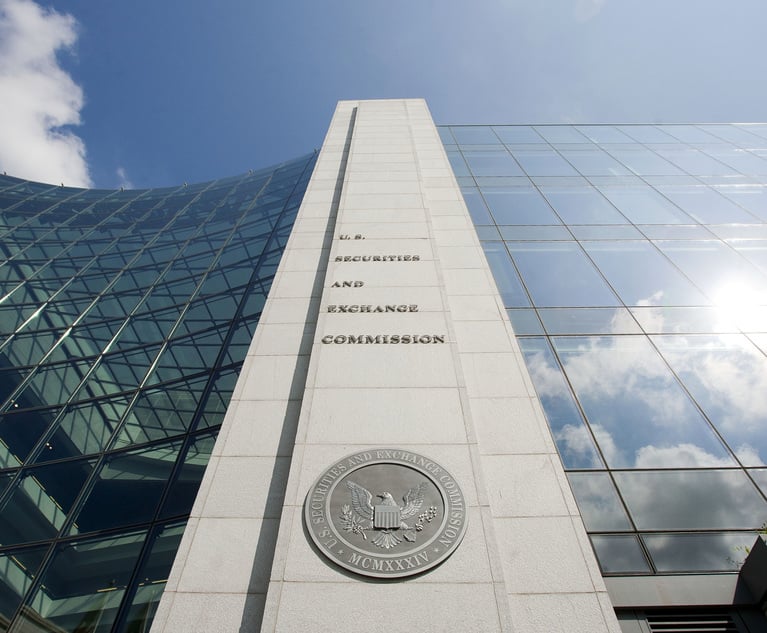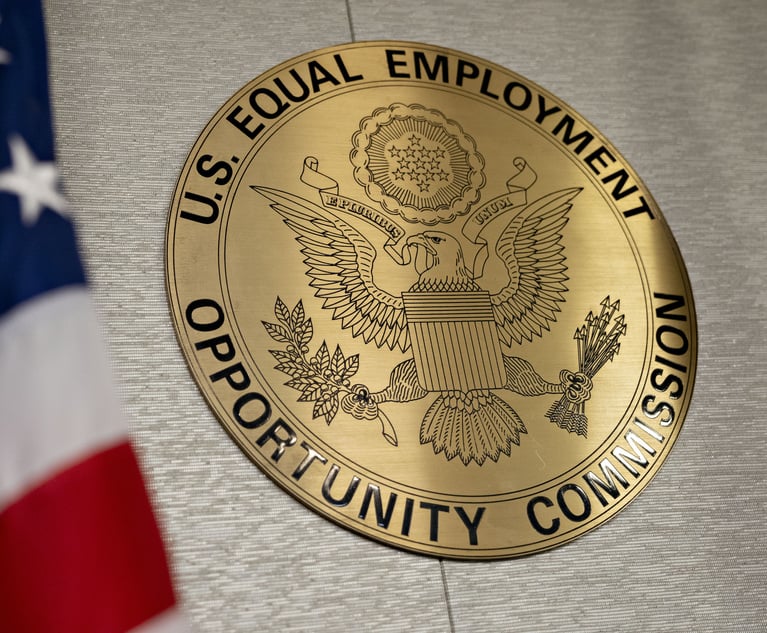Litigation: Quantity versus quality of work
There is a famous mathematical concept called the Infinite Monkey Theorem.
September 27, 2012 at 07:55 AM
7 minute read
The original version of this story was published on Law.com
There is a famous mathematical concept called the Infinite Monkey Theorem. The theory suggests that an infinite number of monkeys sitting at an infinite number of typewriters for an infinite amount of time will ultimately produce the complete works of Shakespeare. While this might be mathematically true, there are more efficient ways to get a copy of Hamlet. There are also more efficient ways for litigators to work through the discovery process than casting the widest possible net.
Most clients have litigation budgets. But even if there is no actual budget, there are limitations on the amount of time and money a client is willing to spend on the resolution of a dispute. Of course, there are exceptions. The late Nicholas Katzenbach, general counsel of IBM, once told a concerned shareholder that there was no limit on the expense IBM was willing to incur to defend itself against the suit by the U.S. seeking to “break it up.”
But where there is a budget, there is an allocation process. Should the budgeted amount be spent on discovery or on resolution? The trial should receive the bulk of the budget—either avoiding it, or, if it occurs, winning it. This makes trial lawyers, judges and clients happy.
In discovery, quantity does not equal quality. With the slowdown the industry has seen over the last few years, some litigators have more time to spend on discovery. That doesn't mean that's how they should spend their time. That type of approach has three key drawbacks.
1. It's grossly inefficient. Discovery is one of the most expensive parts of any case regardless of how it's conducted. A catch-all approach multiplies those costs.
2. It dilutes the focus and momentum of a case. It not only creates more extraneous information, it can provide the opposition with more ammunition to confuse or confound your central arguments.
3. It creates a fog in which the legal decision making process must be made. Long and drawn out cases wear down clients (not to mention lawyers and judges), diminishing their will to try the case.
It seems to me that our job is to cut through clutter of case work, not create more. Our job is to develop the key points of persuasion, not unending parades of witnesses, evidence and testimony at every turn. I'm not suggesting that litigators should not be thorough. But too often we confuse thoroughness with a thoughtless approach that gathers a wealth of meaningless information and does little to prepare an attorney for trial. Over the years, I've identified three steps to take during the discovery process that ensure a more efficient result.
1. Build a prototype argument
An internet search of the word “evidence” will return more than half a billion results. Unfortunately, this exercise is not too far from the way some litigators approach the discovery process. One of the first and most important decisions in any litigation is to correctly map the scope and boundaries of relevant information. The same process is used by FBI search and rescue teams, brilliant doctors and pioneering scientists. To conduct the most effective search, litigators must create a prototype argument. Then they must determine the exact categories and possibilities of evidentiary information and create a plan to collect, analyze, prioritize and synthesize their argument. In short, effective discovery is goal-based.
But any good litigator will tell you that every case has surprising twists and turns. The argument that you attempt to build prior to discovery may not match perfectly with the facts you find. The goals change. For the most effective litigators this is the fun part. Their initial argument may not be their final one; it merely provides the proper framework for the investigation. More importantly, even as the case evolves it keeps the focus on the facts that will be most helpful at trial.
2. Ask surgical questions
The preamble to any deposition can be deadly. Some lawyers call it the dredge: State your name, tell me where you were born, where did you attend school, what courses did you take, did you participate in any extracurricular activities, what training do you have and so on. Start at the beginning and work your way to the end. Cover the entire life of the deponent. The key question in the “dredge” examination is, “and what happened next?” Or, just for the sake of variety, “and then what did you do?” That's the convention.
But I like to think of myself as an unconventional lawyer. I like to ask questions at depositions, which are directed to elicit something relevant. Modestly, I call it “performing surgery.” Asking “surgical” questions. This is particularly true of depositions, but an effective litigator should be surgical in his approach to the entire discovery process. Every witness prepared for a deposition will be told what to expect. That prediction, if it is unrealized, can shake the confidence of the deponent and lead to greater candor and a real payoff from a deposition.
For this reason, I try to avoid routine inquiries in depositions. Most of the time, I think the hours spent on “education since high school” and “positions held since graduation” are a waste of time. If one is committed to investigate for potential prevarication, fine. But most of the time, no investigator is hired to find out whether the deponent did obtain her degree or dropped out in the last semester of her senior year. Most of the time, the information obtained is totally useless and quickly forgotten. But when considering depositions in the context of what you will need for trial, they have three main purposes:
- To pin down the witness so you can cross examine with assurance of some answers
- To learn facts you don't already know
- To intimidate
3. Beware of the e-abyss
I've always been a proponent of using technology in the practice of law connected to advocacy. Using real time depositions; displaying documents to the court and jury digitally and not using paper or foam core boards can help enhance an advocate's case. In most cases technology also helps eliminate inefficiencies by making presentations quicker and more effective. But when it comes to discovery, it's created more inefficiencies. In the digital age we live in, any given case has thousands, and sometimes millions of discoverable digital documents. This has put a drain on lawyers' time and their clients' bank accounts. E-discovery has become a never-ending e-abyss.
It's impossible to conduct a case today without some form of e-discovery. Even physical documents usually have some sort of digital counterpart. But just because a lawyer has access to thousands of emails and files doesn't mean that he should try and discover them all. With that much information there are liable to be results that support his argument and others that refute it. Additionally, these documents still require some level of human judgment to decipher. For a thousand documents, that's a lot of man-hours. Just like in all discovery, successfully navigating the e-abyss takes a targeted approach. Working with clients to develop key search terms and fields will narrow the results. Further aligning those terms with a prototype argument will make the results far more meaningful.
Conclusion
Sometimes to achieve a winning result, it's necessary to dig further and deeper for clues. But a litigator could have every document remotely relevant to the case. She could talk to every person who ever knew the key players. But if she doesn't have a plan or a clear strategy, she may very well miss something important anyway. I would argue that gathering too much information makes it more likely that litigators will miss the mark. And they'll cost their client a lot more money in the process. So, there really is no dilemma.
This content has been archived. It is available through our partners, LexisNexis® and Bloomberg Law.
To view this content, please continue to their sites.
Not a Lexis Subscriber?
Subscribe Now
Not a Bloomberg Law Subscriber?
Subscribe Now
NOT FOR REPRINT
© 2025 ALM Global, LLC, All Rights Reserved. Request academic re-use from www.copyright.com. All other uses, submit a request to [email protected]. For more information visit Asset & Logo Licensing.
You Might Like
View All

Trending Stories
- 1'Lookback Window' Law for Child Abuse Cases Constitutional, State High Court Finds
- 2Troutman Pepper Says Ex-Associate Who Alleged Racial Discrimination Lost Job Because of Failure to Improve
- 3Texas Bankruptcy Judge Withdraws Ethics Complaint Against Jackson Walker
- 4Apply Now: Superior Court Judge Sought for Mountain Judicial Circuit Bench
- 5Harrisburg Jury Hands Up $1.5M Verdict to Teen Struck by Underinsured Driver
Who Got The Work
J. Brugh Lower of Gibbons has entered an appearance for industrial equipment supplier Devco Corporation in a pending trademark infringement lawsuit. The suit, accusing the defendant of selling knock-off Graco products, was filed Dec. 18 in New Jersey District Court by Rivkin Radler on behalf of Graco Inc. and Graco Minnesota. The case, assigned to U.S. District Judge Zahid N. Quraishi, is 3:24-cv-11294, Graco Inc. et al v. Devco Corporation.
Who Got The Work
Rebecca Maller-Stein and Kent A. Yalowitz of Arnold & Porter Kaye Scholer have entered their appearances for Hanaco Venture Capital and its executives, Lior Prosor and David Frankel, in a pending securities lawsuit. The action, filed on Dec. 24 in New York Southern District Court by Zell, Aron & Co. on behalf of Goldeneye Advisors, accuses the defendants of negligently and fraudulently managing the plaintiff's $1 million investment. The case, assigned to U.S. District Judge Vernon S. Broderick, is 1:24-cv-09918, Goldeneye Advisors, LLC v. Hanaco Venture Capital, Ltd. et al.
Who Got The Work
Attorneys from A&O Shearman has stepped in as defense counsel for Toronto-Dominion Bank and other defendants in a pending securities class action. The suit, filed Dec. 11 in New York Southern District Court by Bleichmar Fonti & Auld, accuses the defendants of concealing the bank's 'pervasive' deficiencies in regards to its compliance with the Bank Secrecy Act and the quality of its anti-money laundering controls. The case, assigned to U.S. District Judge Arun Subramanian, is 1:24-cv-09445, Gonzalez v. The Toronto-Dominion Bank et al.
Who Got The Work
Crown Castle International, a Pennsylvania company providing shared communications infrastructure, has turned to Luke D. Wolf of Gordon Rees Scully Mansukhani to fend off a pending breach-of-contract lawsuit. The court action, filed Nov. 25 in Michigan Eastern District Court by Hooper Hathaway PC on behalf of The Town Residences LLC, accuses Crown Castle of failing to transfer approximately $30,000 in utility payments from T-Mobile in breach of a roof-top lease and assignment agreement. The case, assigned to U.S. District Judge Susan K. Declercq, is 2:24-cv-13131, The Town Residences LLC v. T-Mobile US, Inc. et al.
Who Got The Work
Wilfred P. Coronato and Daniel M. Schwartz of McCarter & English have stepped in as defense counsel to Electrolux Home Products Inc. in a pending product liability lawsuit. The court action, filed Nov. 26 in New York Eastern District Court by Poulos Lopiccolo PC and Nagel Rice LLP on behalf of David Stern, alleges that the defendant's refrigerators’ drawers and shelving repeatedly break and fall apart within months after purchase. The case, assigned to U.S. District Judge Joan M. Azrack, is 2:24-cv-08204, Stern v. Electrolux Home Products, Inc.
Featured Firms
Law Offices of Gary Martin Hays & Associates, P.C.
(470) 294-1674
Law Offices of Mark E. Salomone
(857) 444-6468
Smith & Hassler
(713) 739-1250







